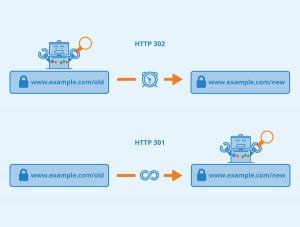
Redirect SEO Best Practices
In its simplest form, a typical redirect looks like a command given to the browser (or a server) to forward a visitor to another page. Redirects are in place to direct both users and crawlers to the most relevant content/resource for the topic, replacing the old content.
There are two general types of redirects, server side redirects and client side redirects.
Server side redirects are redirects at server level; a HTTP request for a file is received by a server, and answered with an appropriate status code, indicating the redirect and its nature – permanent or temporary.
Redirect types:

Permanent redirects (301 or 308 HTTP status codes) – These redirects should be used when you’ve removed or deleted a page permanently from the site’s architecture, yet want to preserve its traffic, rankings, and links. A 308 redirect is used when the request method cannot be changed for the destination URL, and a POST redirect is required.
Temporary redirects (302 or 307 HTTP status codes) – These redirects help forward traffic to a new URL only temporarily. You should use it whenever you need to block user access to a particular page for a limited time. The “302” or “307” status codes indicate that the file (a document or a web page) has temporarily moved to another URL. Similar to the 308 redirect, a 307 redirect is used when a POST redirect is required.
Common redirecting mistakes:
- Redirects not set before a new site goes live
During a migration, it is a common mistake to allow the new website to go live without setting the redirects from the previous website. This results in the new website going live, potentially being crawled and indexed, then being seen as duplicate content and performing poorly. Redirects should be in place beforehand and the new site should be submitted to Google Search Console to encourage Google to understand the redirects.
- Redirecting to a irrelevant URL
Redirects should be as relevant as possible to the original content. This prevents the user journey being disrupted and allows Google to better understand the relationship between the two pages.
- Creating redirect chains; with pre existing redirects
Redirects leading into other redirected URLs are called redirect chains. This can greatly slow download speeds and negatively impact user experience as browsers/crawlers have to send multiple HTTP requests to get the final destination URL. Crawlers may not follow the entire redirect chain, resulting in crawlers never seeing the final content. During a migration, redirect chains can be formed unintentionally by not addressing the existing redirects on the site, then further redirecting them on the new site.
- Crawl budget
Search engine crawlers have a limited time to go through all your content. Redirects may use up the crawl budget for unnecessary redirect jumps, instead of evaluating the content that matters. This results in important content not being indexed and ranked appropriately, and negatively impacting organic performance overall.
- Redirect type usage

To help optimise crawl budget when using redirects, is to use the appropriate redirect type where required. If a resource has been permanently moved, a 301/308 redirect is appropriate. If a 302/307 redirect has been used for this; crawlers will be encouraged to return to these redirects to see if anything has changed; eating away at crawl budget.
Redirects best practices summary:
- Use permanent/temporary redirects where appropriate
- Update temporary redirects when required
- Set redirects to as relevant as possible destination URLs (where the redirect points to)
- Avoid redirects leading in to other redirects
- Have redirects in place before a new website goes live
If you need help with implementing your redirects to ensure your organic performance is not negatively impacted; or your SEO strategies in general, please reach out to the Digital Carrera team!
 Pinterest
Pinterest Twitter
Twitter Facebook
Facebook

